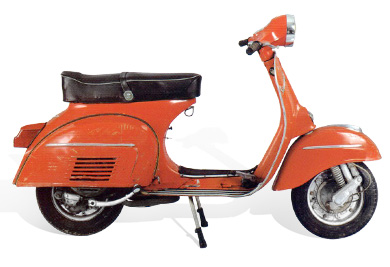very good
4.7 / 5
Shipping today with order in 11 h 58 min
Postage free from 99€ (DE)
High customer satisfaction
Shipping today with order in 11 h 58 min

In 1969, the GT125 becomes the GTR 125 while retaining the same chassis prefix (VNL2T). During the construction period of the GTR models, a technical change took place 'under the hood', away from the old 2-channel engines and towards the modern technology of the upcoming PX 3-channel engines. Parallel to the Sprint150 models, which underwent the same careful modernization while retaining their external appearance, the GTR125 is the version for the 125cc class.
OPTICS
Instead of the trapezoidal headlight, the handlebars with large round headlight also used on upcoming vehicles such as the Rally, Sprint Veloce and TS are now fitted. This also means that the speedometer shape changes from a shell shape to the slightly smaller design of the Rally and Primavera models. In addition, the rear light has already been changed to the more modern type of the Rally200 models. This is now made entirely of plastic and has a plastic cover attached to the top, which is black on the GTR models. The lettering has also changed. At the rear, instead of lettering in stylized handwriting, a square frame with block letters (125 g.t.r.) is used as on the Rally models. The vehicle colors and the color of the side hood rubbers also change. Otherwise, everything remains visually the same as on the previous GT models.
TECHNOLOGY
The engine technology of the GTR125 has its roots in the traditional power unit of the first largeframe engines with rotary valve intake control, as presented with the introduction of the VNB models.
This means that the crankshaft is mounted 'on the fly' in two equally sized crankshaft bearings (these are not held in place by circlips but only by the shaft seals in the engine housing). The engine has only two overflow channels in the cylinder and engine housing (hence the general term 2-channel engine). Furthermore, the first series still have a multi-part wheel bearing on the gearshift detent side. The first engine generations also still have a gearshift cross with bar and split shift bolt. The initially installed SI20/17 carburetor is replaced by a more powerful SI20/20D (as in the later PX125-150 models).
The most important change came with the change of crankshaft type and the associated change of crankshaft bearing. From chassis no. 145901, a crankshaft was installed that was also used in the later PX models. At the same time, the bearing on the alternator side was changed from the large 613912 drawing bearing to a standardized industrial needle bearing type NBI. On the clutch side, the crankshaft bearing was not changed, but it was now fixed in place by a circlip and the oil seal now sits in front of the bearing (seen from the inside of the crankcase). The crankshaft bearing on the clutch side is now lubricated by the transmission oil and no longer by the two-stroke mixture.
An important advantage of this new design was that the crankshaft could no longer move when the clutch was operated. The crankshaft stub was now also significantly stronger, which meant that it was virtually impossible for the stub to break off when the engine power was increased. This also meant that the pole wheel was given a larger cone, but was still operated with a contact ignition. The same ignition base plate was later used in the P125X models (without indicators, Italy).
This change was also accompanied by a switch to the clutch type of the PX models. Identical in principle to the Sprint models, the height has been changed here.
Milestones in the engine history of the GTR 125 models
From frame number 124014: Changeover of gearshift cross and gearshift bolt to PX old type
From frame number 138957 (vehicles with battery): Conversion from 2-channel to 3-channel technology (cylinder and engine housing)
From frame number 145901: Conversion of kick starter pinion pressure spring to coil spring (previously leaf spring)
From frame number 145901: Conversion to crankshaft type, crankshaft bearings, shaft seals, clutch for PX models
from frame number 145901: Conversion of pole wheel, ignition
from frame number 151279: Conversion of carburetor from SI20/17 to SI20/20 (vehicles with battery were already converted from frame number 138957)
up to frame number 151592: Sprint type gearshift lever
Frame numbers by year of construction
1968: VNL2T 100001-100751
1969: VNL2T 100752-107340
1970: VNL2T 107341-112891
1971: VNL2T 112892-117898
1972: VNL2T 117899-124092
1973: VNL2T 124093-128068
1974: VNL2T 128069-135902
1975: VNL2T 135903-141381
1976: VNL2T 141382-145658
1977: VNL2T 145659-149641
1978: VNL2T 149642-151788






